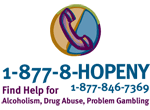
![]()
KEY FINDINGS IN DRUG ABUSE
WHAT ARE SOME OF THE MOST HELPFUL FINDINGS
FOR ALCOHOL/DRUG ABUSE PREVENTION?
HERE IS WHAT THE EXPERTS SAY:
| o PERCEPTION OF
HARM: As perception of harm rises, drug use decreases. As individuals are
taught and come to realize the true harm from alcohol, tobacco and other drug abuse...
drug use and abuse naturally decreases.
o DISAPPROVAL
OF USE: The more disapproval of drug use and intoxication by family, friends
and society... the lower the incidence of drug use overall.
o DELAY IN ONSET
OF DRINKING: Research demonstrates that the greater the delay in onset of
drinking ( i.e., the individual doesn’t start drinking until age 21 or 24), the less
likely he or she is to abuse alcohol, and the less likely he or she is to progress to use
of other drugs.
o CONSUMPTION IS NOT RECOMMENDED: In a report released by the Federal Government in October 1991, it was stated that The Consumption of Alcohol is NOT RECOMMENDED. Drinking has NO net health benefit... is linked with many health problems... is the cause of many accidents... and can lead to addiction. Their consumption is not recommended. If adults do elect to drink alcoholic beverages, however, women should consume no more than 1 drink per day, and men should consume no more than 2 drinks in any given day. Some people should not drink at all, including: women who are pregnant or trying to conceive, people with a family history of alcoholism (especially children of alcoholics), individuals using medicine (even over-the-counter kinds), children and adolescents, and individuals who have an alcohol or other drug problem. o PARENTAL SUPERVISION: New research by the NYS Office of Alcoholism and Substance Abuse Services has demonstrated that PARENTAL SUPPORT (when children are loved, valued, praised and encouraged) and PARENTAL CONTROL (monitoring your children’s whereabouts and what they are doing) are factors that may actually predict the extent of alcohol abuse, delinquency, school problems and other related problems. In addition, the researchers also found that PEER ORIENTATION also continues to be a primary influence on adolescent behavior (when children value the opinion of their peers over their parents in regard to important decision making, they are high risk for alcohol/drug abuse and other problem behaviors). o PROTECTIVE AND RISK FACTORS: Research demonstrates that RISK FACTORS an adolescent has (ex., being alone at home 2 or more hours per day; having hedonistic and self-serving values; overexposure to TV; being under stress "most" or "all" of the time; being subjected to negative peer pressure; lacking social support; being victimized by sexual, physical or emotional abuse; having addicted parents; etc.) are highly correlated with high-risk behavior such as alcohol/drug use, attempted suicide, high levels of sexual activity, etc. Alone, these "deficits" may do no harm, but together they can block, limit or inhibit healthy teenage behavior and contribute to risky behavioral choices. The more PROTECTIVE FACTORS (such as Family Support, parent communication, parent involvement in the school setting, involvement in community organizations or activities, caring about people’s feelings, high school performance and educational aspiration, friendship making skills, etc.) one has, the less likely that person is to engage in high risk behaviors. Prevention then, consists of a two-pronged approach - to prevent deficits and to promote assets.o RAISING POSITIVE KIDS: According to Forest Tennent, M.D., "Parents: if you are a non-smoking, non-drinking, churchgoing, consistent, family-oriented, loving, disciplinarian, the odds are overwhelmingly in your favor that you will raise a positive, drug-free child." KIDS ARE LIKELY TO COPY OUR SELF-DESTRUCTIVE BEHAVIOR: 81% percent of parents who drink have children who drink, but 72% of parents who don’t drink have children who don’t drink. |

